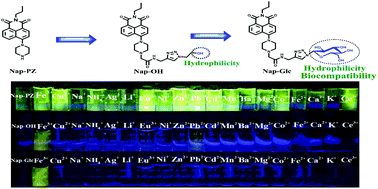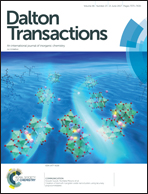A glycosylation strategy to develop a low toxic naphthalimide fluorescent probe for the detection of Fe3+ in aqueous medium†
Abstract
A glycosylation strategy based on click chemistry was employed to develop a naphthalimide-based Fe3+ fluorescent probe with low cytotoxicity and good water-solubility. The selectivity and sensitivity to Fe3+ of three synthesized naphthalimide-based fluorescent probes follows a Nap-PZ < Nap-OH < Nap-Glc trend, because Nap-PZ was modified with a good water-soluble group. The cytotoxicity follows a Nap-PZ > Nap-OH > Nap-Glc trend, because the exposed toxic group of Nap-PZ was shielded by a good biocompatible group. The detection limit toward Fe3+ ion follows a Nap-PZ (7.40 × 10−6 M) > Nap-OH (2.73 × 10−7 M) > Nap-Glc (4.27 × 10−8 M) trend. Moreover, Nap-Glc could be used to detect Fe3+ in living cells. The fluorescent “off–on” response of Nap-Glc towards Fe3+ could be recognized by the naked eye, and the “off–on” fluorescent mechanism also was demonstrated by theoretical calculations. Therefore, Nap-Glc is a novel glucosyl naphthalimide fluorescent probe for environmental or biological detection of Fe3+ with low cytotoxicity and good water-solubility.



 Please wait while we load your content...
Please wait while we load your content...